

 The South African
The South African
by Prof I B Copley, Dept of Neurosurgery, Medunsa
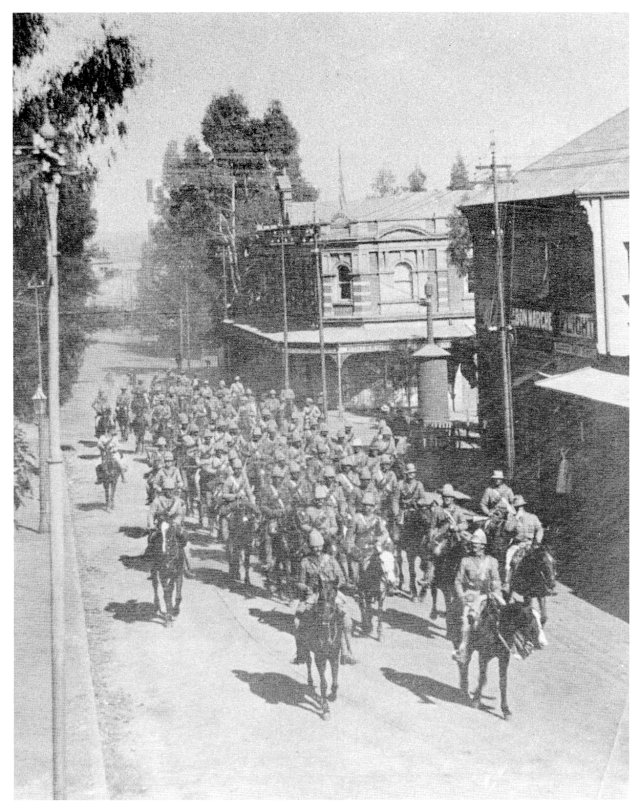
Mounted Infantry entering Johannesburg (SA National Museum of Military History)
Officers of regiments of the Cavalry such as the Carabiniers (6th Royal Dragoon Guards) were able to visit Johannesburg when it was only fifteen years old and admire the 'fine buildings, broad, clean streets, luxurious hotels and well appointed clubs' and the surrounding suburban villas in contrast to the 'one-horse townships' they had experienced thus far. They also commented on the high prices.(2)
In view of his over-extended lines of communication, Lord Roberts was faced with the question of whether he should move on to Pretoria. The railway line, stretching 1 000 miles to Cape Town, was in constant threat of Boer guerilla attacks, particularly across the Orange Free State where General Christiaan de Wet was lurking with some three thousand men and ten guns at his disposal. Attacks had already occurred at Roodepoort near Heilbron, Lindley and Biddulphsberg and there had been considerable damage to the railway line.(3) Provisions in Johannesburg were limited.(4)
Intelligence reports suggested that any defence of the Pretoria forts was exceedingly doubtful and, knowing that the chase must continue, Roberts hoped that the fall of the capital would affect Boer morale, government and administration.(5) Paramount in his thoughts were the 4000 British prisoners of war who were responsible for much of the Boer prestige and who could be moved out of reach and provide the much needed reinforcements.(6,7)
On 2 June, two 9.45-inch and four 6-inch howitzers arrived which could be used for the bombardment of the Pretoria forts. Other supplies had been collected in the meantime.(8)
On 3 June, Lord Roberts began the march on Pretoria. For some days previously, the country had been thoroughly reconnoitred up to 12 miles north of the Jukskei River. Resistance in the rough, hilly country ahead was not anticipated. He directed Cavalry generals Sir John French and Sir Ian Hamilton to move to Rooikrans and Diepsloot respectively and thence to Skurweberg, well outside the range of the Daspoort Fort, the most westerly point of the Pretoria defences. French was then to continue around westwards, falling upon the railway line north of Pretoria and, in so doing, cutting the road link with Rustenburg and the western Transvaal. The main body of the army would follow the Florida-Pretoria road to Leeukop and Vlakplaas to gain the northern bank of the Six Mile Spruit ahead of Pretoria.(10)
In his Boer War memoirs, General J C Smuts criticised Lord Roberts for failing to prevent the departure of President Kruger and the Boer Government by train along the Delagoa Bay Line by not making a sudden night march to surprise Pretoria in order to capture the government with their reserves of money (£0.5 million) and ammunition, as though these options could not have entered Lord Roberts' head.(11)
On the contrary, at 18:00 (railway and telegraph time, Greenwich Meridian Time + 1.5 hours, or 18:30 SAST) on 1 June, 200 mounted men under Maj Hunter-Weston RE, of General Gordon's brigade with the American scout, Mr Burnham, who had been brought up by the Red Indians, were on their way to blow up the bridge on the Pretoria-Delagoa Bay railway line at Bronkhorstspruit, 20 miles (32 km) east of Pretoria. Unfortunately for the British, the party was discovered by the Boers at 09:00 on 2 June, attacked by greatly superior numbers and forced to retire. The attempt was then abandoned, although it served to intimidate President Kruger and encouraged his departure to Machadodorp to establish the seat of the government there.(12)
Hunter-Weston and Gordon's eastern flank objective could perhaps have been attained by a brigade of cavalry supported by mounted infantry. At this stage, success in cutting the line might have obviated the fight at Diamond Hill and ensured the collapse of Boer resistance. The emphasis on the western wing may have been due to the belief that Kruger would retreat to Rustenburg in the western Transvaal where his main support lay. Lord Roberts did not wish to dissipate his force, as he was unaware of the true strength of the forces at Pretoria. Neither did he wish to travel or arrive at night.(13)
From the watershed of the Johannesburg ridges, the country to the north descends gently from 5 000 feet (1 524 m) to 4 000 feet (1 219 m) across undulating ground incised by several river courses flowing northwards. All these rivers and streams drain into the Crocodile River in order to pass beyond the Magaliesberg, the last of three parallel mountain chains in the north.
The first range of low hills, the Witwatersberg, marks the transition from dolomite limestone rock to the quartzite of the Magaliesberg, hence the name of one of these passes, Kalkheuwel, or Lime Hill, also the name of a farm in the vicinity. The dolomite rock acts as a sponge for the perennial flow of water from springs and rivers into the Crocodile River system which, together with the Apies River at Pretoria, ensures that the farming areas always remain prosperous, even in times of drought.
Some 5 miles (8 km) further on, lies the second line of hills, the Skurweberg quartzite range, which has the same characteristic north-south tilt of the rock formation as the much larger Magaliesberg. Whereas the first two ranges of hills can be traversed through any number of passes and defiles, the Magaliesberg range can only be crossed via a limited number of passes or neks which were important in controlling movement in the western Transvaal.
Initially, the going underfoot for the cavalry was reasonably good, but it became progressively worse approaching the 'jaws' of the southern entrance to Kalkheuwel Pass. On the higher ground to the western side of the pass and further north on the eastern side of the defile, jagged, exposed and weathered dolomite spines competed with the height of the grass. The going was difficult on foot and almost impossible for horses and tranport, restricting virtually all cavalry movement in the pass to the road itself.
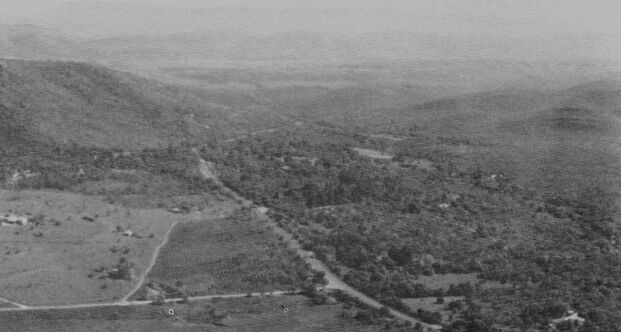
Aerial view of Kalkheuwel Pass from the south, showing three rows of hills.
The U-shaped gap in the distant Magaliesberg is Silkaatsnek
The road follows the western bank of the small Sterkwaterstoop [sic] Stream curving gently to the northeast at the foot of the crags.
Having narrowed to a small defile, the valley opens out again before forming another defile, finally debouching with the Sterkwaterstoop Stream onto the banks of the Crocodile River. In this area the ground was, and still is, very marshy (Map 3). Consequently, instead of continuing down the second defile, the original road turned sharply to the north-west and climbed out of the valley, 'up a very steep hill', before descending towards Broederstroom and the Skurweberg. This section still exists as a dirt road off to the left, whereas the modern highway continues down the pass towards the Crocodile River at Welgegund Drift, but does not cross the river.
The road continued along the beautiful Broederstroom valley to open on to the floor of the fertile Moot, or valley, in front of the majestic Magaliesberg range. Here the Kalkheuwel road joined the Pretoria-Rustenburg road on the western bank of the Crocodile. Turning east and passing over the wooden 'Paul Kruger' bridge on General Hendrik Schoeman's farm, the road ran along the Moot directly to Pretoria. An alternative route ran and still runs over Silkaatsnek to reach Pretoria via Wonderboom on the northern side of the range (Map 1).
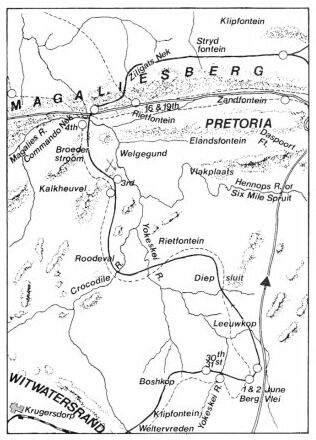
Map 1: Route taken by the 1st and 4th Cavalry Brigades and the Mounted Infantry (dotted line)
between Bergvlei and Pretoria via Silkaatsnek (adapted from Goldmann)
The western part of the entrance to Kalkheuwel Pass along the road was traversed by two low ridges descending obliquely north-easterly from the higher ground on the west (Map 2). The road passed between the highest points of the first ridge and then around the eastern end of the second as it dropped towards the mouth of the gorge. The 'jaws' of the pass were overlooked by the sharp prominence 'A' (1463, Map 3) and the ridges on either side, which completely dominated the approaches and the road itself. Hill 'B' (1379, Map 3) on the eastern side, was less dominant, being further away from the road and offered less protection for troops in possession of it.
The enemy, consisting of General S P du Toit's Commando, with the Mafeking (Mafikeng) Commando acting as a rearguard, had recently come up from Frederikstad with part of a force which had been dispersed by General Hunter at Fourteen Streams near Warrenton. The objective of this force was to check 'the anticipated wide turn movement' through Commando Nek or Silkaatsnek(14).
Generals French and Hamilton proceeded northwards to Rooikrans and Diepsloot, Hamilton taking up the rear. At Diepsloot, French learned that the only drift over the Crocodile River suitable for their wagons was at Roodewal, 5 miles (8 km) due west via Rietfontein, southwest of Pretoria (Map 1). He was obliged, therefore, to recross the Jukskei further downstream and reached Roodewal at noon just upstream of the Crocodile/Jukskei junction, having marched 25 miles (40 km).(17,18)
French's force now consisted of the 1st and 4th Cavalry Brigades with General Hutton's 1st Mounted Infantry Brigade in close support. The order in which they arrived at the ambush site and came into action was:
The 1st Brigade, commanded by Lt Col (Brig Gen) T C Porter (6th Dragoon Guards) which comprised:
The Carabiniers (6th Royal Dragoon Guards) with 17 officers, 289 men, 251 horses; the Scots Greys with 18 officers, 302 men, 308 horses; the Inniskillings (6th Inniskillings Dragoon Guards) with 27 officers, 268 men, 224 horses; 'T' Battery, Royal Horse Artillery (RHA), with 6 officers, 138 men, 154 horses and six 12-pounder guns; the Brigade pom-poms (two Maxim-Nordenfeldt 1-pounders) with 1 officer, 15 men, 17 horses.
The 4th Brigade, commanded by Maj-General J B B Dickson comprised:
7th Dragoon Guards with 21 officers, 272 men, 139 horses; 8th (King's Royal Irish) Hussars with 18 officers, 299 men, 158 horses; 14th (King's) Hussars with 14 officers, 297 men, 187 horses; 'G' Battery, RHA, with 5 officers, 115 men, 108 horses; the Brigade pom-pom with 1 officer, 12 men, 26 horses.(19,20)
In addition to the cavalry, General Hutton's Mounted Infantry, consisting of 1st, 2nd, 5th, 6th and 7th Corps (which included Canadian and Australian troops, such as the 1st and 2nd Battalion, Mounted Rifles (Col Evans), 1st Australian Horse and the New South Wales [NSW] Lancers) amounted to 2 300 men, making a total force of 4 536 officers and men(21). 'O' Battery, RHA, was in support of the Mounted Infantry. (22) At noon, the Crocodile River was crossed and the troops were allowed to rest in the warm noon sunshine. Some units, such as the 8th Hussars, managed to find bundles of forage from farm buildings on the western bank.(23)
On the way to Kalkheuwel, 'two privates in the Canadian regular force, William Pearce, a twenty year old farmer, and John Alexander Hopkins, a twenty-four year old plumber, and a British sergeant, "who styled himself on Sergeant Jones of French's Scouts," relieved a group of Boers of their rifles and ammunition, then sold the articles back to them. Why they did not rob them of their money in the first place is difficult to understand. As they were completing their transaction, several of Rimington's Scouts appeared, one of whom spoke Afrikaans, and discovered what had occurred. The two dragoons and the British sergeant were arrested and tried in Pretoria for "assisting the enemy with arms," and sentenced to ten years' penal servitude.'(24)
An advance guard of Scots Greys reconnoitring ahead at this time, saw the dust of a large Boer convoy passing from west to east at full speed between 3 to 5 miles (5 to 8 km) away, heading for Kalkheuwel Pass and, presumably, the Welgegund drift on the Crocodile River beyond. Somewhat later, at 14:15, the 14th Hussars and NSW Lancers saw the same wagons, twenty-five in number, travelling towards the pass ahead.(25) The column pushed on at such a pace that the Boers were forced to abandon two ambulances.(26)
The Carabineers were sent to intercept the convoy before it disappeared. However, the advance troops were fired upon by the enemy from a ridge 2 miles (3 km) north-west of Roodewal. The 8th Hussars lacked the strength to attack the enemy's escort and timeous assistance did not arrive. They could see the native drivers urging the cattle and wagons along. At about 14:30, the Scots Greys managed to surprise the enemy, capturing several wagons, oxen and some prisoners.(27) It was thought that the horses had been taken away to remove the guns, but the prisoners would not admit to this.(28)
'O' Battery, RHA, and one of the 1st Brigade pompoms were called up to shell the convoy and also the hills occupied by the Boers, driving them back. The enemy seemed to disappear down the pass.(29)
General French ordered Hutton and his Mounted Infantry, with 'O' Battery, to bivouac 3 miles (5 km) north of Roodewal and protect the rear, whilst the cavalry pushed on towards Kalkheuwel Pass, now only a short distance away.(30)
The advance guard continued to push the enemy back from ridge to ridge with the assistance of the RHA and the 1st Brigade pom-pom.(31). Alternatively, the Boers retired, drawing the cavalry on from ridge to ridge and exhausting the horses which had already had a long march(32).
General French was in a hurry to gain control of the Welgegund crossing before dark. He called up 200 of Maj E A H Alderson's 1st Corps, Mounted Infantry, to the centre and sent the 1st and 4th Cavalry Brigades out to encircle the enemy's flanks.(33)
Col Porter's 1st Brigade deployed to the enemy's front and left or eastern flank, bringing the guns of 'T' Battery, RHA, to bear on the Boer rearguard on the ridge west of the road, the highest part being Kalkheuwel, before the Boers appeared to yield the entrance to the gorge.
The 4th Brigade made a wide turning movement towards the enemy's right or western flank, but could only make slow progress over the rough ground encountered.(34). They continued advancing along the western heights. The terrain prevented the advance squadrons of Inniskillings from pushing on and cutting off the enemy to the north of Kalkheuwel. Consequently, the 4th Brigade was ordered to return to the road. A troop of Inniskillings under Lt Patterson, keeping cover between the 1st and the 4th Brigades, found itself alone in guarding the left flank on the high ground. The troop maintained this position, despite being shelled, at a later stage, by their own side.
The road was rough with little room to manoeuvre on either side due to the rocks and bushes. It was quite unsuitable for the cavalry.(35). 'O' and 'G' Batteries were supporting from the rear along the road.
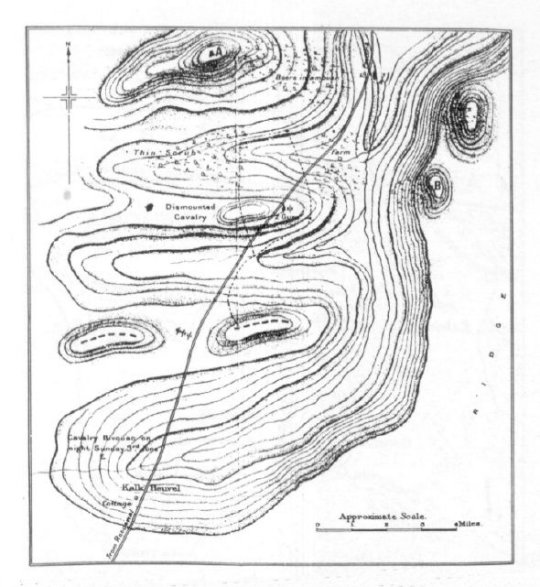
Map 2: The ambush at Kalkheuwel Pass, 3 June 1900.
The approximate scale should be in furlongs (Goldmann)
The 1st Brigade was still in the lead when the 4th Brigade returned to the road, falling in immediately behind them. Alderson's element of mounted infantry, the New South Wales Lancers, brought up the rear.(36,37)
There was no sign of the Boers by 16:30. Despite the fact that the cavalry had marched 38 miles (61 km) and there was barely an hour's daylight remaining, French wished to capture the Crocodile crossing at Welgegund, assuming that the Boers had already crossed it. However, natives reported that the Boers and their wagons were still in the pass.(38)
The cavalry pressed on into the jaws of the pass.(39) The leading sections of the 1st Brigade were composed of Carabiniers and Inniskillings. In the evening light, they described the pass as being a 'deep, narrow defile shut in by a double row of rugged kopjies' and 'steep frowning hills held by Boers'.(40,41)
General French sent two squadrons of Inniskillings to search the ridges on the left and one squadron of Scots Greys to the right. Before the flanking patrols had completed their searches of the ridges, the advance troops had entered the defile.(42)
'A' Squadron of the Scots Greys and part of 'C' Squadron under Maj W C Middleton took Hill 'B' commanding the pass on the right (1379, Map 3) and remained there all night, losing one man and some horses wounded.(43)
The Inniskilling advance guard under Lt Rundle continued ahead and saw two abandoned wagons. The leading patrol, comprising an NCO and two men, came upon Boers on the hillside on the left and gave the alarm. Boers were secreted on either side of the gorge, but mostly on the left, amongst the rocks and bushes.(44)
Consequently, the Boers were forced to fire prematurely, before the main body was completely jammed in the pass. The main body of troops had, in fact, just descended into a slight dip in the road commanded by a high rocky hill to the front (1463, Map 3).(45)
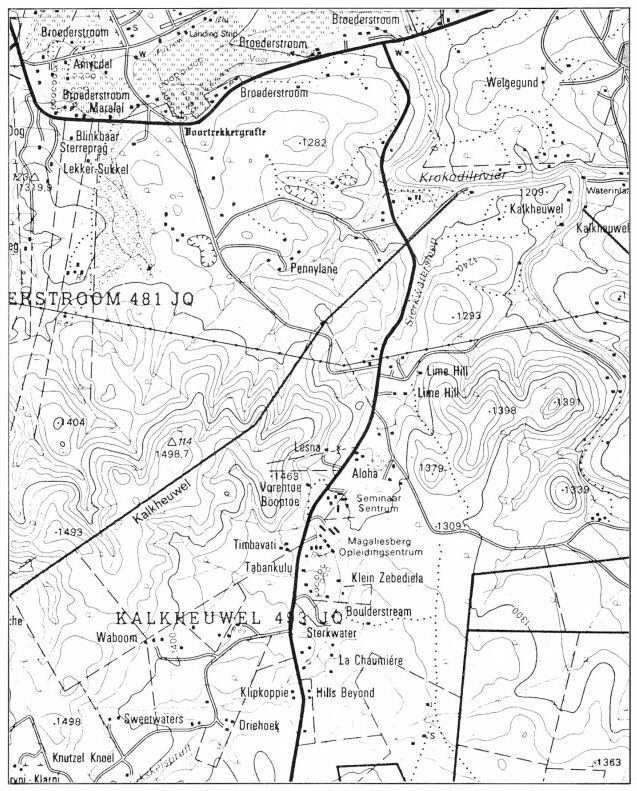
Map 3: Ordnance survey map showing the modern road through the pass
The original road followed the modern alignment as far as the minor road
off to the left halfway down the pass
The Boers' sudden firing on the over-confident horsemen is variously reported as occurring at 16:00, 16:30 and 17:00.(46,47,48,49) (It seems most likely to have occurred between 16:30 and 17:00 SAST). The weak setting sun in a cloudless winter sky would have cast sharp, dark shadows in the pass and there would have been about an hour of useful light remaining.
The Boers also started firing onto the road from the hill ahead and from the ridges on either side of this eminence (1463, Map 3). Two men of the advance party of Carabiniers were killed and another was mortally wounded. Lt Rundle had three horses shot from under him and Capt Johnson lost one.(50). The main body of troops was so close behind that the Boers were able to fire onto the compacted mass from the ridges and even from the left rear. The intense rifle fire was supplemented by Boer shells.
When the shooting began, General French and his staff with the NSW Lancers at the head of the main column had come up with Col Porter almost on top of the advance guard to assess the situation(51). The advance guard of Carabiniers came galloping back, leaving 'a trail of killed and wounded' as Alderson's mounted infantry rear also came up.(52)
The advance guard under Maj Hamilton of the Inniskillings also retired precipitously onto the main body under shell and rifle fire at 300 yards, adding to the confusion. Maj E H H Allenby (Inniskillings) was almost overwhelmed by horses galloping back on him. He shouted, 'For God's sake, Lancers, don't run away if the rest do.' He instructed the NSW Lancers under Maj Lee and part of 'A' Squadron of Inniskillings, which he had with him, to dismount and deploy to the bushes on either side of the road, although most of his own men had fled, leaving him behind. The rally, centred on Maj Lee, who remained mounted in the middle of the road under heavy fire, prevented a panic from arising while the guns were coming up.(53)
General French ordered all troops to dismount. He and his staff had had to gallop back to the rear echelons, out of range. He called for the guns to be brought up and for an assault on the ridges from the road.
Maj Hamilton's Inniskillings, in the advance guard, held their ground. Father Knapp, a Carmelite who had only just joined the brigade, was most heroic in attending to the dying on the road under heavy crossfire.(54)
The cry, 'Make way for the guns!' was passed back. The gallant gunners of 'T' Battery, commanded by Maj F B Lecky, gave a 'marvellous display of their coming into action.' 'Everyone seemed to keep their head. Everything seemed to be taken as a matter of course' after the initial confusion. 'Dispositions were quickly made, officers and men seemed to anticipate their orders and soon were more than holding their own. The noise was deafening: guns, pom-poms, mauser and our own fire - one continuous roar, echoed and re-echoed amongst the hills.'(55)
'T' Battery and the 1st Brigade pom-pom were under heavy rifle fire. At first, only the leading gun could come into action on the road. The guns had to be manhandled off the road due to the rough terrain.(56). Miraculously, however, the gunners suffered no casualties.
The 'T' Battery diary entry states rather nonchalantly, '[we] had a fight there in the pass which for a short time was a nasty situation. The left section and pompom which were pushed forward were in action at the critical time.' Their ammunition and supply wagons were lost again in the confusion caused by the unexpected congestion along the road and the advent of darkness.(57)
'O' Battery in the rear with the mounted infantry was ordered up with the 4th Brigade pom-pom and two Vickers Maxim machine guns to take position on the low ridge to the left of 'G' Battery on the road behind 1st Brigade. They were firing shrapnel rounds at the peak and ridges.(58) 'The Boers fired thousands of rounds in reply. Their guns were kept for safety well up [sic] the pass, so they did no execution among us.'(59)
At the same time, General French had called for an assault of the ridges on both sides of the pass by the Canadians of Maj Alderson's 1st Corps, with the Carabiniers acting as infantry. He was determined to win the pass before dark.(60,61) The Boers were well hidden and the bombardment did not seem to have much effect on their rifle fire. 'O' and 'G' Batteries were in action at 1 000 yards (914 m) (62)
From the bushes on either side of the road, the Lancers and some of 'A' Squadron Inniskillings, with the Carabiniers and the 1st and 2nd Battalions, Canadian Mounted Rifles, assaulted the ridges on both sides, but mainly on the left. The Boers, 'discovering that the Lancers had taken cover in a natural drain or ditch, worked up the hill above them on the left to where they could snipe at any man who moved or showed any part of his body.' They 'were under fire . . . for two hours until dark and each man expended an estimated two hundred rounds so that his rifle's barrel grew so hot that it blistered his hand.' Most of the time it was a case of 'lying low or stopping one.' By dark the enemy was beginning to 'spot' them individually and their range was accurate. One lancer, who had been left behind, asked an English officer where his comrades were. The officer replied, pointing down the road, 'They are down there in a perfect hell, and there won't be one-third of them ever come out alive.'(63)
Both heights were captured with slight casualties just as darkness fell.(64,65). The 1st Battalion, Canadian Mounted Rifles, remained on the western heights for the entire night(66).
The Lancers, who seem to have been pinned down, made their escape in the darkness. They had expected to find most of their pals on the road and in the drain, riddled with bullets, but they kept straggling back in two's and three's until midnight. The roll was called and it was found that there were 'none missing', which led to an all-night celebration around a fire.(67)
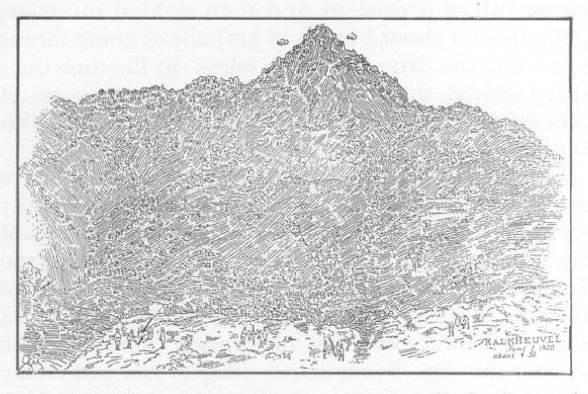
Sketch of the disposition of the guns facing the dominant feature of the pass
(formed by a conglomerate intrusion into the dolomite) [Goldmann]
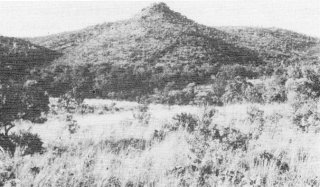
Modern photograph of the entrance to the pass
taken from approximately the same position as the above
During the action in the defile, the 1st Brigade was supported by elements of the 4th Brigade. 'C' Squadron, 14th Hussars, was sent to the right of the road where elements of the 1st Brigade were extended amongst the rocks. Maj Brown brought up the squadron which dismounted with Lt Hill-Whitson's troop to the right of the 1st Brigade pom-pom, close to the guns. '[There] was a mixture of some of the Inniskilling Dragoons and some of Hutton's Mounted Infantry and the squadron formed upon the right, two machine guns on the left, while a squadron of the 7th Dragoon Guards came into action on the right of the squadron.'(68)
'A' Squadron of the 8th Hussars had gone a little too far to the east and could have faced the enemy unsupported. However, they captured several prisoners and rejoined the brigade late at night.(69)
Lt Patterson (Inniskillings), in an advance on the heights ahead to the left, served well by staying there when the 4th Brigade turned into the pass, becoming their only protection by denying the position to the Boers, who could otherwise have worked around to the rear of the British force.(70)
As it grew dark, firing was sustained by rifle flashes on both sides and sniping continued for a further two hours. The crashing had given way to a 'deadly stillness', punctuated by occasional shots.(71) There was a first quarter moon which set at about 22:00.
The Boers took advantage of the darkness to withdraw.(72) They left six wagons abandoned in the stream bed.(73)
The troops had no choice but to bivouac where they
were in the pass at Kalkheuwel, all crowded together.
The position as darkness fell was as follows:
The Carabiniers were checked in front, with the
Inniskillings in support on both flanks in the pass and
on the ridges. They also had with them the guns of 'T'
Battery, the NSW Lancers and the Canadian Mounted
Infantry. The Greys commanded the pass from their
hill on the right. The remainder of the 1st Brigade and
the 4th Brigade were crammed into the pass. Due to
the confusion and congestion of the gun teams on the
road in the darkness, the transport had not yet caught
up. The bulk of General Hutton's Mounted Infantry,
with the exception of Alderson's Corps, were still to the
rear, about a mile further back to the south-west.(74)
Owing to the non-arrival of the transport, the troops only had recourse to the tinned soup and potted meat they had carried in their wallets. The 8th Hussars were fortunate to occupy the farmyard (see farm marked on Map 2). Having been issued with flour on the previous day, Sergeant-Major Morton decided to light a fire and make some small 'chupatties' - little cakes of flour and water fried in fat. He ate a couple, placed the remainder in his haversack and went to get a drink of water from the Sterkwaterstoop. On his return, he found his horse eating the last one - all his food for the next day.(75)
The sergeant-major appears to have survived both the two 'chupatties' and the water from the stream, which must by then have become contaminated. Drinking from the stream is mentioned more than once. It is no wonder that enteric was more deadly than the enemy. Fortunately, at that time of the year, the water would have been ice cold and there would not have been many flies. Maj A F Russell of the Greys remained healthy and never missed a parade throughout his two years service. He attributed it 'to the fact that he never drank unboiled water.'(76)
The 4th Brigade provided the pickets for the night: 'A' Squadron, Lt Jameson and 'B' Squadron, Lt Walker, of the 14th Hussars. 'C' Squadron managed to join the regiment later in the evening.(77)
The vulnerable position lasted until morning, since it was impossible to correct the situation in the rear on the narrow road in the dark. In view of this, casualties were remarkably light. Two men of the Carabineers, Sgt W Belshaw and Pte Hall were killed in the initial ambush. Cpl A N Blackman died of wounds during the night. They were buried in the pass.(75) An officer and five men were wounded. Unfortunately 48 horses were lost from a force that was already short of mounts.
Ammunition expended was: 119 shrapnel 12-pounder shells, 275 Maxim-Nordenfeldt (pom-pom) 1-pounder shells, 10 141 small arm, including machine gun, rounds.(79)
During the night, the Boers and their convoy disappeared. Their route and ultimate destination immediately afterward is not stated, but they had the option of moving westwards towards Rustenburg via Commando Nek or, less likely, to the north via Silkaatsnek. Once over the Magaliesberg, the whole 'wilderness' of the northern Transvaal was open to them. The convoy was last seen moving northwards the next morning.(80,a). They would have been too late to take their guns to assist in any defence of Pretoria.
On the morning of 4 June, the pickets were relieved. Lieutenants Grosvenor and Hill-Watson relieved Lieutenants Walker and Jameson at 06:00 at ftrst light (sunrise was at 06:46 SAST).(81)
Burial parties were formed to deal with friend and foe alike. The 8th Hussars buried a number of Boers found on the ridges. At the foot of the hill on the opposite side of the road (east), they found six abandoned wagons, two Boer ambulances and several wounded men and a Boer doctor (one ambulance was full of provisions, chiefly tinned sardines and salmon) (82,83). Female garments were strewn by the wayside, sacks of mealies, coffee and flour dumped in the stream 'showing the panic of their flight'(84)
General French subsequently told Maj Allenby that he had much to thank the Australians for that afternoon. Allenby corrected him: 'The New South Wales Lancers alone, sir!' The 1st Australian Horse had taken no part in the resistance, although that squadron had suffered the casualty of one man wounded in the ambush, whereas the Lancers had come off scot-free. Other sources attribute this conversation to Col Porter and Maj Allenby.(85, b)
Boer casualties are given as having been a maximum of 33 and a minimum of 20 killed.(86,87,88). The actual number of the 'many' wounded is not mentioned.
The Inniskillings had the grave of a 'field cornet' pointed out to them.(89,c)
Congratulations were received from the General Officer Commanding, Cavalry Division, who 'ordered commanding officers to express to their regiments his extreme satisfaction with the conduct of the officers and men of the regiments on the occasion of the fight near Kalkheuwel yesterday. He considered the position to have been very critical and is of the opinion that had it not been for the prompt action of the Cavalry and the RHA' the result might have been different.'(90)
Col Porter took a party of 1st Brigade down the lower pass to secure the Crocodile crossing where the river curved around Welgegund and decided that it was not suitable for his transport. (91)
The march was resumed at about 06:30 with the sun just above the horizon and the pass in deep and chilly shadow. The Scots Greys moved off half an hour later.(92,93) The 1st Btn Canadian Mounted Rifles, being situated on the heights which also commanded the advance along the road to Broederstroom, were ordered to form the rear guard. However, as the troops and baggage took so long to get through the pass, they had to remain there a second night before forming the rear guard.(94).
The NSW Lancers were given the honour of forming the advance party. They came upon the Boer ambulance wagon full of provisions and then sighted the convoy going flat-out about 5 miles (8 km) ahead going through a pass into the Broederstroom valley. By the time the artillery arrived, the Boers were already out of range. The Lancers took the lead once again and remained there until the column crossed the Crocodile River.(95)
The 1st Cavalry Brigade took 'a very steep', 'narrow and rocky' road up the hill, winding out of the pass towards Broederstroom at 07:30.(96) Some Boers were holding a position covering the road. There was distant shelling from the hilltops of the Witwatersberg, the second line of hills. There was no delay until about 11:00 when 'G' Battery with the 4th Brigade came into action to clear the way. Some native villagers had gathered on one of the hilltops to see the fun, but as they could not be distinguished from Boers at that range, they were also shelled for their trouble. Once a few shells found their range, the Boers departed, not to mention the villagers. 'A' and 'B' Squadrons of the 14th Hussars (4th Brigade) were sent forward to the eastern side of the road to hold a hill of the Witwatersberg as flank guard.(97)
Many accounts mention the orange groves in the beautiful, fertile Broederstroom valley. The 8th Hussars found a farm opposite a grove (from which most of the troops pilfered oranges) 'in the grounds of which a very long table had been laid, a repast for our retreating enemy.' The troops carried off as many oranges as possible, 'stowing them away in every possible space' on their persons or in their accoutrements. Here, some Boers gave themselves up.(98)
At about 13:00, the 1st Brigade and the 14th Hussars crossed the wooden 'Paul Kruger' bridge over the Crocodile River near Hartebeespoort to the right-bank and by 14:00 they reached General Hendrik Schoeman's farm, 'Schoemans Rust', a mile or so further on, where they camped. Here the 14th Hussars learnt that thirty Boers had been killed in the previous day's battle.(99)
'A' Squadron of the Inniskillings, sent to reconnoitre Silkaatsnek, found it to be clear.(100) Consequently, 'A' Squadron of the Scots Greys under Maj W C Middleton was sent forward to occupy the Nek as well as Put's Drift on the Crocodile on the northern side of the Magaliesberg.(101) They could hear the big guns near Pretoria during the day and in the same general direction saw the army's war balloon.(102)
The soldiers also met a Scot who kept a store on the right-hand side of the road up Silkaatsnek and kept some zebras that he drove in harness.
'A' Squadron of Inniskillings was recalled and bivouacked at Rietfontein (Rietfontein West) 'in a very nice valley' with other units of the 1st Brigade including 'T' Battery, RHA.(103,104)
Presumably the site offered not only a commanding view of the Moot but good views of the approaches via Commando and Silkaatsnek, as well as being easily defensible.
The 4th Brigade and the Mounted Infantry bivouacked on the left bank of the Crocodile for the night Elements of the 4th Brigade seized Commando Nek 2 miles north-west of their bivouac.
General French arrived at the 'Paul Kruger' bridge and met his old opponent, General Schoeman, 'whom he had fought and battled for ten weeks at Colesburg.' Schoeman obtained a protection order in return for an oath of neutrality (105) General French decided to spend the night there.(106)
On 5 June, the 1st and 4th Cavalry Brigades with 'G', 'O' and 'T' Batteries RHA moved over to the northern side of the Magaliesberg and marched eastwards. They caught up with the Scots Greys at 09:00.(107) Again, a seemingly endless supply of oranges and tangerines was found and appropriated by the thirsty soldiers.
General Hutton and the Mounted Infantry crossed the bridge over the Crocodile, but remained south of the Magaliesberg, travelling along the Moot slightly to the rear of the cavalry on the north side. They maintained communications and cleared passes in succession on their way to Pretoria, having heard about its fall.(108)
They camped west of Pretoria at Zandfontein, having seized Daspoort Fort on the way.
On 6 June, the 4th Brigade continued on to Koedoespoort, east of Pretoria, on the Delagoa Bay railway line, occupying Wonderboom Fort en route (109)
The 1st Brigade reached Waterval on 6 June in time to release 36 officers and 3500 men and return them to Pretoria by rail.(110)
The energy and rapidity of the left wing manoeuvre, it is said, could have been used to better effect on the right, by cutting the railway to the coast. Conversely, the Boer government might have been able to flee westwards by road, or northwards by rail, rather than eastwards by rail as it transpired. Only a combined flanking movement could have prevented either eventuality and Roberts might have thought that he lacked sufficient forces to dissipate in this manner. It was a matter of ill fortune that the objective of blowing up a bridge on the railway line to the east failed.
The Boer tactic carried out by du Toit was largely unsuccessful in preventing or delaying the cavalry movement west and north of Pretoria. He could have turned the confusion in the pass into a disaster, had he not concentrated his forces and retaken the ridges at first light and not removed his own guns. In addition, the Boers had considerable casualties, killed and wounded, and they lost about eleven wagons, including ambulances with a doctor and a quantity of stores.
That the cavalry placed themselves in a vulnerable position in the pass is not disputed, and a disaster could easily have occurred that evening or the following morning against a more formidable enemy.
Despite having been at the mercy of the Boers during the ambush, the British casualties were insignificant and seem to have occurred mainly as a result of the first shots at point blank range.(d) The cavalryman's instinctive reaction to dismount and take cover in a terrain that benefitted friend and foe alike, resulted in the exposed horses taking the brunt of the attack. Further losses of horses could have seriously hampered completion of the westward sweep, which was a costly exercise in horse losses in any case. Shortly after the battle, the Scots Greys were down to 30 horses out of 308. Their officers were down to 15 after starting out with 26 before the relief of Kimberley.(111)
Witnesses to the action state that, had the left wing pressed forward along the heights, they could have cut off the Boer convoy climbing out of the pass, as the road is dominated by the same heights overlooking it at the entrance to the pass. It is unlikely that even infantry or dismounted cavalry could have surmounted the obstacles provided by the Boers and the terrain to reach such a position in force in the time and lighting available. As it was, the Canadians had occupied the heights by nightfall and were in that position the following morning. It was never suggested that the Canadians could or should have done more. There was also no significant moonlight to assist them after dark (first quarter, setting at 22:30). The sudden, perpendicular change in the direction of the road leaving the pass may not have been as obvious on the evening of the battle as it was the following morning, which is suggested by the preoccupation with the Crocodile crossing at Welgegund. This crossing would have been of little use to the Boers fleeing north or west and of little more use to the British since the existing road exploited the wooden bridge crossing at 'Schoeman's Rust', connecting directly with the road over Silkaatsnek as well as the southern road to Pretoria along the Magaliesberg. The same road runs to Rustenburg over Commando Nek in the opposite direction.
Although the Boers possessed artillery, their effectiveness seems to have been quite haphazard when compared with the RHA whose conduct was praised and officially recognised. The Boer guns were too far back to be effective. A man of Scotch descent told the Greys the following day that they had 'had a narrow escape in the worst part of the pass as the Boers had four guns commanding the place. An order had come from Pretoria ordering their immediate removal a few hours before we came. He said that he could not understand the Boers letting us through.'(112)
Yardley 'sought to excuse French's over-confident blundering into the trap "at so late an hour and in such a random way" as "probably" a consequence of realizing that his enemy was not sufficiently enterprising to take advantage of his rashness.' 'If so, he was perhaps correct, for his opponents relieved the pressure by withdrawing under cover of the dark.'(113)
The Boers seemed more preoccupied with extricating their convoy, putting up only a token resistance the following day before melting into the countryside, which was, as yet, uncontrolled by the British forces.
b. Maj E H H Allenby, 6th Inniskilling Dragoons, became Field-Marshall the Viscount Allenby GCB,GCMG.(115)
c. This is probably the 46 year old Field Cornet P Kruger who was killed at Rhenosterspruit, an adjacent farm, and buried (with an inscribed stone later) at the foot of Silkaatsnek. This unlikely burial site may be the only direct evidence that the Boer convoy took this route during their retreat. The only other known casualty was a Field Cornet Smit who died of wounds at Rhenosterspruit farm on 10 June 1900.(116)
d. The NCO and two men killed in the ambush were Sgt W Belshaw, Pte Hall and Cpl A Blackman, who died of wounds during the night. They were buried in the pass near the road. In 1962 they were re-interred at Rietfontein West Consolidated Military Cemetery at Hartbeespoort. The site of the original cemetery is no longer known.(117)
Return to Journal Index OR Society's Home page